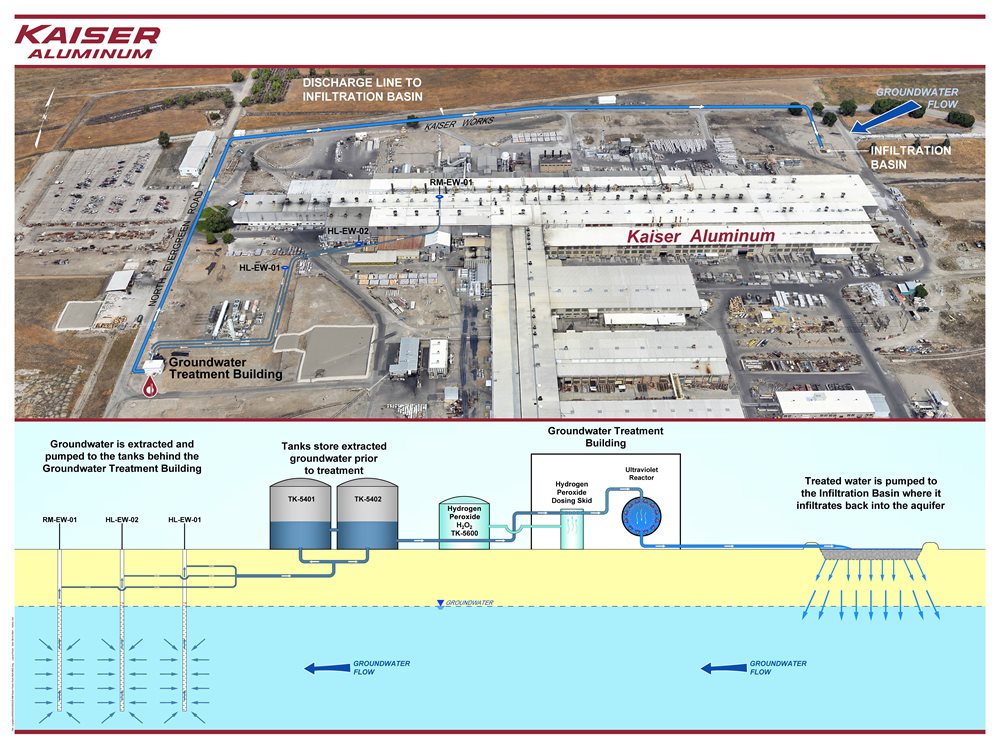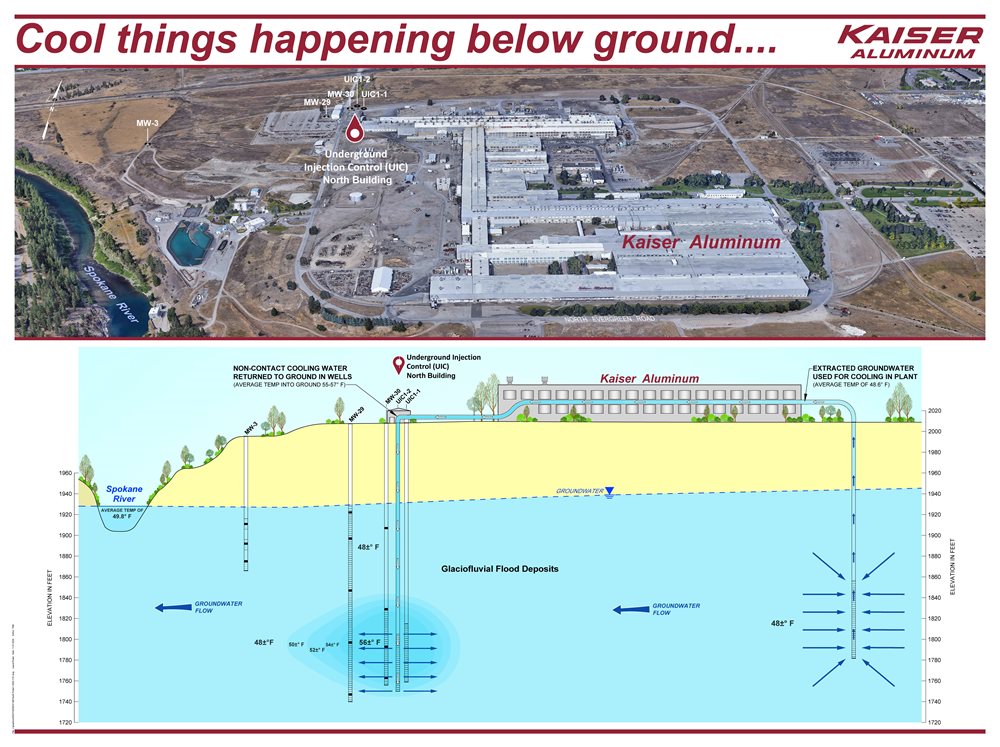The UV reactor where contaminated water is inundated with PCB-destroying ultraviolet light.
At full-scale, Kaiser can now treat 200 gallons of contaminated water per minute and destroy up to 99% of PCBs in water. The first bench-scale test system they built in 2020 treated 5 gallons of water per minute. Treated water coming out of the UV light system meets drinking water standards and is returned underground through an infiltration basin upgradient of the PCB plume in groundwater.
The Trentwood facility, near the Spokane River in Spokane Valley, has produced specialized aluminum products for more than 75 years, and previously used PCB-containing oils to safely and efficiently operate hydraulic equipment. Over the years, some PCB oil leaked, contaminating groundwater under the aluminum-casting building. They have been working on addressing legacy contamination related to aluminum production since 2010 and have completed a number of interim cleanups along the way.
PCBs harm health and the environment
As early as 1936, serious skin irritations and other health effects were noted in industrial workers exposed to PCBs, which led to increased protection for workers but didn’t slow their manufacture. By 1976, it was clear PCBs were also an environmental problem. The Toxic Substances Control Act (TSCA) was passed and banned the majority of PCB uses and restricted remaining concentrations to low levels. This law was in effect by 1979.
Unfortunately, PCBs last for a very long time in the environment. This is a concern not only for plants and animals, but also for people. PCBs have toxic effects to the immune, reproductive, nervous, and hormone-regulation systems in humans and other living things. PCBs cause cancer in animals and are considered likely to cause cancer in humans. They also build up in living things, which is amplified when predators eat prey.
Did we mention UV light and hydrogen peroxide destroy PCBs?
The development of an economically feasible treatment technology proven to destroy rather than just capture PCB contamination in water is exciting! PCB contamination is widespread throughout Washington and found in almost every water body in the state.
Often cleaning up environmental contamination just means moving it somewhere it can be safely contained. For example, we take contaminated dirt to a lined landfill or dispose of contaminated water filters. However, the contaminants still exist. Kaiser initially pilot tested a walnut-shell pump-and-treat system before they began testing the UV light system in 2020. In the walnut-shell system, a small amount of castor bean oil was added to contaminated water and the water was filtered through crushed walnut shells. The PCB clung to the oil, which was then removed by the walnut filter. While this system removed about 70% of PCB from extracted groundwater, it only captured the PCB, and the contaminated castor oil and walnut shells had to be further treated or properly disposed of at a licensed landfill.
The UV light system destroys contamination without creating waste byproducts that must be disposed of elsewhere. The system Kaiser has built could also be used for broader applications, such as wastewater treatment for municipalities.
Keeping process water clean to protect groundwater and the river
Inside the Underground Injection Control building.
Groundwater, which is typically around 48°F, is extracted and piped into the aluminum-casting facility for cooling. The piping is a once-through, closed-loop system that keeps water from directly contacting any equipment to ensure it stays clean and prevents groundwater contamination.
After the water leaves the facility, its temperature has increased to around 56°F when it’s put back underground, called underground injection, to recharge the aquifer. Kaiser monitors groundwater temperatures downgradient of the injection to ensure impacts are minimal and do not affect Spokane River temperatures.
Next steps for the UV light system
Kaiser collects water before and after treatment every month and tests the PCB levels in the samples to track the UV light system’s performance. They will submit a progress report in December to share the results of the first six months of full-scale treatment.
Kaiser will monitor and report on the full-scale UV treatment system’s performance for several years. Our legal agreement with them requires the full-scale system to extract and treat contaminated groundwater at rates that protect the Spokane River. It also requires them to improve and expand the system as necessary. We will write the draft cleanup action plan after we assess the results of the testing and the system’s ability to meet state standards. The draft plan will be available for public review before becoming final.



